Japan
Wood Products Prices
Dollar Exchange Rates of 10th
March 2016
Japan Yen 113.84
Reports From Japan
Five years on
March 11, 2016 marked five years to the day since the
massive 8.9 magnitude earthquake struck eastern Japan.
Five years on recovery work is still on-going but still
around 60,000 people are still living in ‘temporary’
housing units the condition of which has deteriorated over
the years.
Residents in the stricken area were evacuated because of
the damage caused by the quake and tsunami and because
of the radioactive contamination due to the nuclear melt
down. When surveyed everyone in the housing units said
they want to escape the cramped and inconvenient living
conditions as soon as possible.
Two factors have been cited for the delays in rehousing
the displaced, first a shortage of building materials (hard
to comprehend in a country like Japan) and secondly the
desire of those who lost everything to rebuild and reestablish
the community in which they lived before the
disaster.
The government has begun lifting the compulsory
evacuation orders for some communities in the former
radiation contaminated areas and plans to remove any
remaining restrictions in March of next year. However,
many evacuees are reluctant to return fearing radiation
remains high despite the years of decontamination effort.
To get a sense of the task facing Japan see:
https://www.google.co.jp/search?q=japan+earthquake+and+tsuna
mi&espv=2&biw=1034&bih=619&source=lnms&tbm=isch&sa=
X&ved=0ahUKEwjd44SiwLfLAhVCGqYKHfBYBn4Q_AUIBi
gB#imgrc=mKVJqG2DWnvn9M%3A
Consumer sentiment stalls
Japan’s consumer confidence index for February fell to a
one-year low setting another challenge for the government
and the central bank.
The overall index for February was 40.1 (50 marking the
transition from pessimism to optimism). This was the
sharpest decline for years. The livelihood index dropped
from 40.9 to 38.5 while the willingness to buy durable
goods, an indicator for manufactured wood product sales,
dropped to below 40.
The Cabinet Office statement with the data release said
consumer sentiment was stalling and that this prompted a
downward revision of forecasts. The Bank of Japan
introduced negative interest rates in January in a fresh
drive to reflate the economy out of stagnation and help
accelerate inflation - now hovering around zero - to its
ambitious 2 percent target.
See:
http://www.esri.cao.go.jp/en/stat/shouhi/shouhi-e.html
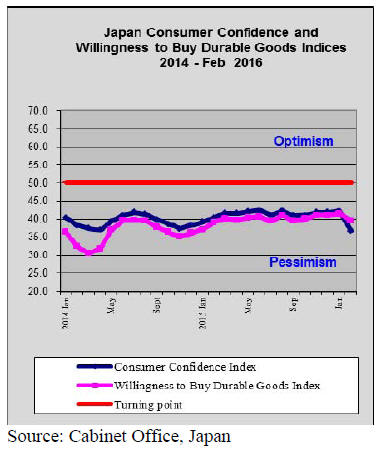
Concern that consumption tax increase could
trigger
another recession
Japan is set to raise the consumption tax by a further 2% to
10% in April 2017 which, because of the current economic
situation in the country, has many politicians worried that
an increase could trigger another protracted recession.
However, Bank of Japan (BoJ) Governor, Haruhiko
Kuroda, is a stanch advocate of the increase and has said
the impact on the economy of the proposed increase is
expected to be much less than that seen after the 3%
increase in 2014 which sent the Japanese economy into
recession. But still, one of the advisers to the Prime
Minister has called for a postponement.
In related news the BoJ Governor has defended the
decision to adopt a negative rate policy saying this will
take time to have an impact.
The main concern of the BoJ is to maintain the yen/dollar
exchange rate at end 2015 levels but the yen has
strengthened about 5.5 percent this year despite the
negative rate policy.

Housing starts drop in January despite fall in
mortgage interest rates
January housing starts were one of the lowest for the past
13 months and only just rose above the dismal
performance of the sector in the first two months of 2015.
Construction orders received by the top builders fell
sharply (-14%) in January in contrast to the rise seen at the
end of 2015. This decline in orders coupled with
weakening consumer sentiment does not bode well for the
sector which had expected to get a boost from the lower
mortgage rates being offered since the Bank of Japan
adopted negative interest rates.
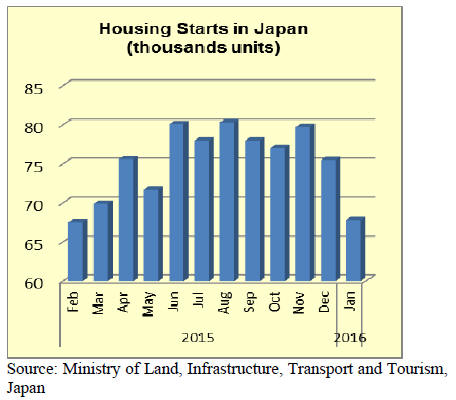
Japan’s furniture imports
The value of Japan’s 2015 imports of wooden office,
kitchen and bedroom furniture dipped in the first half of
the year and then began to rebound. Bedroom furniture
imports showed a strong performance in the last quarter of
2015 and this extended into January 2016.
There was an increase in kitchen furniture imports in the
second half of 2015 and, like bedroom furniture, this
upward trend continued into January 2016.
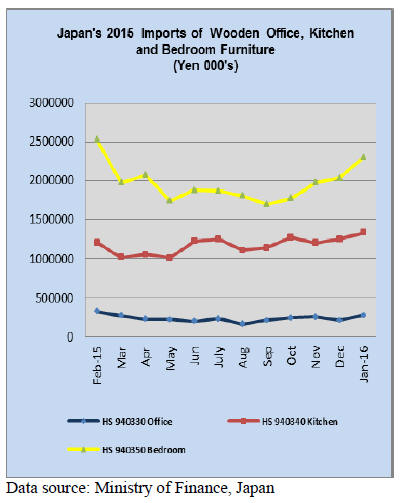
Office furniture imports (HS 940330)
Year on year January 2016 office furniture imports were
down 27% but were the highest since March 2015.
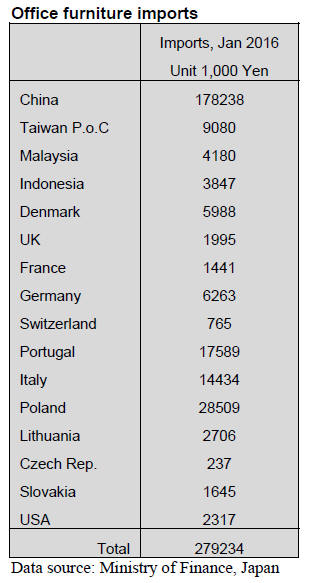
China, Poland and Portugal dominate Japan’s office
furniture imports accounting for around 80% of all imports
of this category of furniture. January 2016 imports from
China were down 15% year on year and there was a
massive decline in imports from Portugal. On the other
hand, imports from Poland were up by a factor of 4
compared to January 2014.
A year earlier imports from Italy lifted the country
to the
third raked supplier but in 2016 office furniture shipments
to Japan were significantly lower.
Kitchen furniture imports (HS 940340)
In contrast to the mixed performance of office furniture
shipments to Japan, January 2016 imports of kitchen
furniture were up 16% year on year with Vietnam,
Philippines and China the top three suppliers accounting
for around 80% of all shipments of kitchen furniture.
January 2016 shipment from Vietnam, the top supplier,
rose 6% while shipments from the second ranked supplier,
Philippines jumped 42%. China was the third ranked
supplier in January 2016 and saw shipments rise 24%.
In January 2016 suppliers in SE Asia accounted for 76%
of Japan’s kitchen furniture imports.

Bedroom furniture imports (HS 940350)
Japan’s imports of bedroom furniture continue to rise, a
trend that began in September 2015. Year on year,
January 2016 imports were down 2% but were the highest
since February 2015.
The main supplier at 59% of all bedroom furniture imports
was China, followed by Vietnam (29%) and Thailand, a
distant 3%.
China’s January shipments of bedroom furniture were
virtually unchanged from a year earlier whereas both
Vietnam and Thailand saw shipments fall.
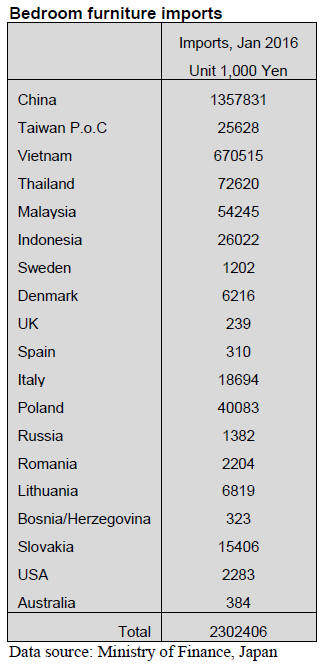
Trade news from the Japan Lumber Reports (JLR)
For the JLR report please see:
http://www.nmokuzai.
com/modules/general/index.php?id=7
Degree of self-sufficiency revised again
A degree of self- sufficiency of domestic wood is
reviewed and revised. The Forestry Agency disclosed a
draft of forest and wood industry basic plan for 2016.
Since the supply in 2015 does not seem to achieve an
initial target of 28,000,000 cbms, a target of 2020 is
reduced from initial target of 39,000,000 cbms down to
32,000,000 cbms and the target set for 2020 to make a
degree of self-sufficiency of 50% is postponed by five
years.
The forest and forest industry basic plan is the national
basic policy of measures on forestry, which is roughly
reviewed in every five years and suggests target of forest
conditions and wood use volume five, ten and twenty
years in future.
The plan made in July 2011 aimed a degree of
selfsufficiency
of 50% with target of wood supply of
28,000,000 cbms by 2015 and 39,000,000 cbms by 2020
but the supply in 2014 was 24,000,000 cbms, far from the
target although it increased significantly from 18,000,000
cbms in 2009 to 24,000,000 cbms. Therefore, the target is
revised based on reality.
Sumitomo Corporation’s capital participation in Brazil
Sumitomo Corporation (Tokyo) announced that it decided
to make capital participation to the world largest pellet
manufacturing company in Brazil. Raw material is waste
sugar cane.
Sumitomo has been enlarging biomass businesses and
thinks waste sugar cane is the most promising renewable
resource, which enlarges source of renewable energy.
The company Sumitomo invests is Cosan Biomassa S.A.,
a subsidiary company of the largest sugar company, Cosan
S.A. Industria e Comercio (San Paulo, Brazil).
Cosan Biomassa is fuel pellet manufacturing company
with raw materials of strained lees of sugar cane (pagas)
and stalks and leaves left in the field after harvest. It has
started the operation in last September.
North American lumber import in 2015
Total lumber import from North America in 2015 was
2,339,457 cbms, 1% less than 2014. This is two straight
year’s decline from previous year. Although new housing
starts in 2015 increased over 2014, import of both North
American and European lumber decreased.
Lumber import did not drop as much as logs from North
America but compared to recent peak year of 2013, it was
18% drop.
Log import from North America in 2015 decreased by
17% but lumber import dropped only by 1% because SPF
lumber increased by 3.1%. SPF lumber takes more than
half of lumber import. 99.7% of SPF lumber was from
Canada with 1,346,291 cbms, 3.2% more. Next to SPF,
hemlock lumber was the second largest from Canada at
291,090 cbms, 11.1% less then Douglas fir was third at
234,660 cbms, 3.6% more.
North American log import in 2015
Log import was 2,565,063 cbms, 17.1% less. This is the
lowest since 2010. Drop of log import from Canada was
30.8% with 802,687 cbms. It was the most noticeable
change while drop of log import from the U.S.A. was only
by 8.8% with 1,762,000 cbms so the share of logs from the
U,S.A. was 68.7% from 62.5% in 2014.
The reason of decline of Canadian log import is that
Japanese plywood mills had production curtailment
program in the second half of last year so the demand of
Canadian Douglas fir logs, which is used for long length
plywood, sharply decreased. Canadian Douglas fir log
volume was 623,000 cbms, 36.5% less.
Total Canadian log import volume of 802,000 cbms was
the lowest since 2009 when the housing starts dropped
down to 780,000 units after the Lehman shock.
Douglas fir logs from the U.S.A. was 1,693,000 cbms, 8%
less. Share of Douglas fir logs from the U.S.A. increased
to 66% but strong dollar, weak yen pushed import cost up
so import of all the other species from the U.S.A. largely
declined.
By species, hemlock import dropped by nearly 10%.
Canadian volume was 125,000 cbms, 6.3% less then
hemlock from the U.S.A. was only 4,136 cbms, 56.2%
less. Yellow cedar (cypress) logs decreased by 45.3% with
9,635 cbms from Canada, 34.7% less and 4,085 cbms from
the U.S.A,, 60.5% less. The demand for imported cypress
dropped after domestic cypress sill prices declined and
took imported cypress market.
Western red cedar increased by 72%. 2,559 cbms, 34.8%
less from the U.S.A. while 7,043 cbms from Canada,
325% more.
European lumber import in 2015
Import of European softwood lumber in 2015 was 2,384
M cbms, 4.6% down from 2014. Although the demand
was slow in Japan, European lumber supply exceeded that
of from North America of 2,268 M cbms and it kept the
top position of softwood lumber import for las tthree
years.
The market of structural laminated lumber and small
common lumber was in slump reflected by sluggish
demand in 2015. Import of main items of lamina and stud
failed to increase the volume but the volume did not drop
so much compared to 2014.
Lamina import did not drop so much because precutting
plants shied away from imported products in fear of
market price drop and shifted to use more domestic
laminated lumber, which has much shorter delivery period
so domestic laminated manufacturers were busy, which
supported rather steady import of lamina.
However, export prices of lamina stayed low, particularly
on whitewood. Sweden, which is one of major lamina
supplying sources, dropped the volume for Japan.
Finland is the largest supply source for Japan with 35%
share in total imported volume. The supply of lumber
including lamina from Finland is expanding as UPM
shifted to concentrate on lumber business.
Plywood
Shipment of domestic softwood plywood continues active.
Increase of shipment for precutting plants since last fall
continues.
The movement in distributing channel had been rather
quiet but in last December, the supply was short and
precutting plants looked for the supply in distribution
channel so wholesalers got busy and tried to secure the
supply.
Precutting plants accommodate small production items
like 28 mm thick panel, panel with tongue and groove with
each other but by last December, such tightness ended.
Until last December, delivery time from plywood mills
was uncertain but now ordered items are delivered in a
month.
Compared to busy domestic softwood plywood market,
imported plywood market continues weak.
The movement of imported plywood slowed down since
last August then there were some movements in December
by some dumping prices.
Basically, the demand for imported plywood decreased so
the dealers buy minimum volume only so they have no
intention to buy with higher prices to secure the volume.
Actually buyers wait until the prices drop by inventory
disposition.
Lower prices stimulate the movement but the volume is
limited. The importers are anxious to have more sales
before the book closing but pushing sales mean loss. The
prices have been edging down little by little.
 
Russian logs and lumber import in 2015
Decline of softwood log import from Russia continues.
Total volume of log import of red pine, larch and
whitewood dropped less than 160 M cbms. Since export
duty rules on softwood logs started in 2007, sawmills in
Japan lost interest on Russian logs and closures have
continued and the market for Russian logs is practically
gone.
Meantime, Russian lumber has not established solid
market. Recovery of the demand in 2015 from drop by the
consumption tax hike did not stimulate the demand so the
total was less than 2014.
Import of whitewood logs was only four months of the
year. Larch is used for plywood and it has steady market
but it competes with North American Douglas fir and
domestic cedar.
|